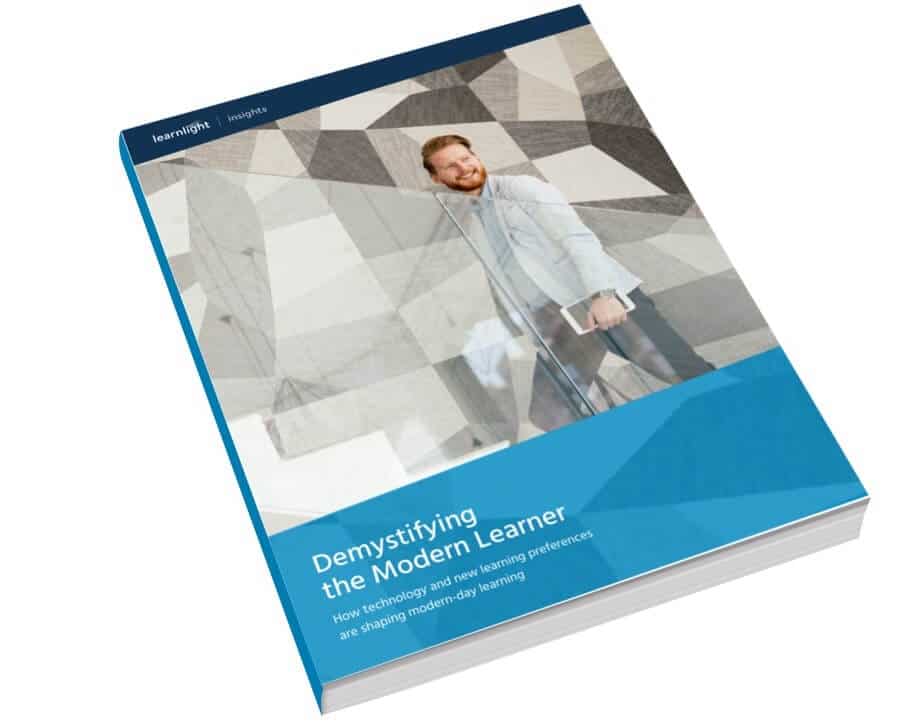What Is Blended Learning? Here Are 7 Key Elements

What is blended learning?
Blended learning is learning that combines face–to–face and technology-driven sessions. It can be done using an online platform or via a dedicated mobile app that effectively contributes to the learning process.
How we learn today is very different from just a few years ago. Face-to-face workshops are being increasingly replaced by learning technologies. However, eLearning courses omit the live trainer and do not always engage or motivate the learner. What we need is an genuinely blended approach.
To blend or not to blend?
That’s a catch-22 situation that confuses many L&D professionals when it comes to creating effective training programs. The truth is that blended learning is no longer negotiable in today’s professional world. Adopting an effective blended learning approach as part of your L&D strategy can help your organization increase employee engagement and improve knowledge transfer to the workplace.

Demystifying the Modern Learner

Demystifying the Modern Learner
We all know that learning doesn’t happen just because you’ve signed up to an online course. By adding a human element – a live trainer – we automatically enhance the “learning through doing” approach and ensure that the skill or competence is transferred into the workplace.
But the challenges don’t stop there. According to Deloitte, only 1% of the working week is available to an average employee for training and development. That’s just 24 minutes in a 40-hour working week to develop talent.
Is blended learning the same as hybrid learning?
Blended learning and hybrid learning are not the same thing, though there is some crossover. Typically, hybrid learning gives learners the option to join live sessions in person or remotely. This method doesn’t give the option to enhance the classroom experience with e-learning like blended learning does
It is widely recognized that modern, corporate learners are time-poor, constantly distracted and very selective when it comes to highly tailored and high quality content.
They are the ones who set the bar high for L&D specialist to create effective blended learning programs. They demand the flexibility to learn synchronously or asynchronously, online or in a classroom, face to face or virtually, individually or in groups.
This means that L&D must keep the needs of the modern learner at the forefront of their training plan. Creating a customized, immersive and human-driven learning experience that’s mobile, instant and in a micro-format requires innovation, imagination and tools that help to make it happen.
There is also evidence that solid blended learning design makes sense from both an instructional and an economic perspective.
Further reading
Why blended learning is the optimal approach to training
In fact, a study from learning analysts Towards Maturity found that 80% of L&D professionals think that the use of blended learning will increase in the next two years.
The same study suggests that the most successful organizations are already using a blended learning approach in their training design. They know that an effective blended learning program can bring multifold business benefits:
- The frequent re-use of content consistently re-enforces the learning experience
- The human element increases the practicality of training, speeds up skills acquisition and improves knowledge retention
- The organization sees a clear alignment between learning and the business strategy
- L&D spend is maximized for the entire learning population
Why is blended learning ideal for corporate training?
“Successful blended learning programs must offer flexibility, combining both instructor-led training as well as effective digital content to deliver optimal results. That digital content must be accessible at any time, from any place, on any device.”
Boost employee engagement
Blended learning can boost your employees’ engagement with learning because it offers a different approach. By having a flexible learning style and access to materials, opens up more opportunities for the employee to take time to learn. It also means that they can come to the face-to-face sessions prepared with any questions they may have, which you wouldn’t be able to with only one form of learning style.
Different formats of learning can also be highly engaging and adapting to employees of different learning styles.
Easier assessment
Online platforms can also have a more seamless assessment process. It is easier to track a learner’s progress and knowledge understanding with the blended learning approach. Learnlight’s lifecycle approach of learning, revising and practicing offers an intuitive learning experience and data management. Having advanced data insights means that the impact on learning outcomes is greater achieved.
Seamless learning communication
By having a mixture of face-to-face and online learning, the blended approach can mitigate any errors or time-consuming communication. Your trainer can easily upload materials via an online learning platform and communicate this. This not only saves time but ensures learners are up-to-date with the latest developments in their program.
The benefits of blended learning for learners
Learners can also take advantage of the following benefits:
- Adapt to different learning styles
- Be more engaged in your learning
- Monitor your own learning and improvements
- More flexibility
- Online materials are widely available
- Increase confidence
- Boosts soft skills
So how easy is it for L&D to implement a blended learning approach in their strategy?
Can blended learning be an L&D challenge?
Yes, the future of learning is blended and about harnessing technology to empower the learner. But L&D lacks confidence in its ability to use learning technologies.
According to a survey from HR company CIPD – “just a quarter of respondents feel ‘extremely’ or ‘very’ confident in their ability to harness technology to increase the effectiveness of their L&D interventions”.
Luckily, there is always another side to the coin. Perhaps using learning technologies in blended learning is not as difficult as it seems.
Mark Oliver, Managing Director at Raytheon Professional Services says that “the right learning strategy is never about merely just adding new media or new technology, but rather using technology as an enabler to support the different cycles of learning”.

Demystifying the Modern Learner

Demystifying the Modern Learner
The only question remains is: how?
How can you create an effective blended learning program that harnesses technology, engages the modern learner and, at the same time, adds value to the organizational business strategy?
7 Key elements for effective blended learning
Here are seven key elements to consider when designing an effective blended learning program:
1. Clear learning objectives
Learning designers must be able to identify and define clear learning objectives before they start creating a blended learning program. The objectives serve as a roadmap:
- To help learners to understand what they can expect from their training;
- To help the designers to monitor where learning is headed;
- To help the managers/program commissioners to understand the topics that need to be covered to successfully achieve the business objectives.
2. The right blended learning model
Broadly speaking, blended learning is a fusion of self-paced online learning and trainer-led face to face learning. Others say that it’s a mix of approaches to learning, supported by technology.
In fact, there are many types of blended learning varying by content, scale, technology, learning spaces, etc., and research seems to prove the success of these hybrids.
Therefore, when designing an effective blended learning program, there should be adequate clarity in establishing how to ‘blend’ online content with a trainer-led method. Learning designers’ task here is to find the right blended learning model that works for the organization and the learners.
3. Flexible, mobile access to learning
It is predicted that Millennials will account for 46% of all US workers by 2020. When it comes to professional development, their need for short bursts of high impact just-in-time learning is paramount.
Since learning happens everywhere, it should be ubiquitous.
Successful blended learning programs must offer flexibility, combining both instructor-led training as well as effective digital content to deliver optimal results. That digital content must be accessible at any time, from any place, on any device.
Today’s learners expect real-time learning experiences with immediate and measurable results. By ensuring that the digital element of your blended learning program has been designed mobile first, your learners can take full advantage of the training offered.
4. Microlearning by design
Using microlearning in your blended training program ensures the effectiveness of learning.
Firstly, microlearning is the antidote to learner disengagement. It fights it by using easy-to-understand elements like bullet points, games, quizzes and graphics to increase learner engagement.
Secondly, microlearning is how our brains like to learn. In his book, Understanding Occupational & Organizational Psychology, Lynne Millward states that information can be comprehended effectively when it’s presented in pieces.
Further reading
Learning nuggets are ideally suited to our brains, which are better at processing small packets of information rather than huge chunks of it.
5. The power of video-based learning
One of the biggest challenges facing L&D departments is rolling out innovative, engaging and compelling blended learning programs to their time-poor learners. A solution? Video-based learning!
It means using short micro-videos to disseminate knowledge.
Learners respond best to multimodal flipped classroom blended training where the use of videos is an important component in the learning process.
Use the videos to prepare the learners for their instructor-led sessions. Flip that classroom so they maximize their time with the instructor. Videos will also consolidate their learning by making short summaries of key points.
6. Relevant and personalized content
In 2015, the RAND corporation undertook the most comprehensive study to date on the subject of the effectiveness of personalized learning. They found that students trying out personalized learning approaches made greater gains in math and reading than similar students at more traditional schools.
As adult learners, we tend to be significantly more motivated by topics and content which are directly relevant to our professional lives, needs and interests. Hence content personalization counts – it ensures that every learner experience is bespoke.

Demystifying the Modern Learner

Demystifying the Modern Learner
An effective blended learning program must draw on learners’ previous experiences, encourage them to be self-aware and to think about how they are going to incorporate new knowledge and strategies into performing their tasks.
The program should also provide multiple opportunities for the learner to practice and concept check, and should drive them to learn by doing.
7. Evaluation of blended learning
As Pombo and Moreira (2012) indicate, there are four elements that need to be taken into consideration when evaluating blended learning programs:
- What is the purpose of the evaluation?
- Who should be involved?
- How and when should evaluation take place?
- What should be evaluated?
There are several methods of evaluating blended learning programs. This insightful Cambridge Assessment Publication analyzed them and concluded that “some frameworks focus on technology over pedagogy, most focus on the student perspective rather than that of teachers or administrators, and some frameworks rely only on course outcome measures”.
When evaluating your blended learning program, make sure that you include all aspects of the program, context and those involved, so that the interconnectedness is not lost.
Further reading
The problem of the traditional mindset
Many people hold the preconception that traditional classroom training is more effective. You may be one of them. This belief is understandable, because a classroom is a familiar environment. Technology-based learning brings too much uncertainty.
But learning cannot be transformed for the better if those responsible for it are not willing to get out of their comfort zones.
It takes effort and confidence to make a blended learning program successful. It also takes careful planning and the cooperation of different parties.
- L&D professionals need to embrace technology and use it in a way that attracts the modern learner, encourages engagement and establishes insight.
- Learners need to be properly introduced to different stages of their blended learning program, so that their experience is positive and enjoyable from the start.
- Managers need to understand what their employees will be experiencing throughout the program, and how they can measure the ROI.
- Facilitators need be comfortable with the blended learning concept and fully support the learners within and beyond the program.
With survey after survey showing that training and development are key to employee satisfaction and retention, putting in place an effective blended learning program that delivers is key for any organization that wishes to stay ahead of the game.
See how Learnlight can help with corporate blended learning programs
We offer a blended learning approach with our innovative online learning platform. With programs including language training, communication training and intercultural training, we offer a variety of training methods to suit your employee learning. Book a demo or contact us for further information.
Share this article
Latest Insights
- Information Security, News
- Globalization, The Power of Diversity
- Corporate Social Responsibility, News
- Global Skills, Globalization
- Corporate Social Responsibility, News
- Digital Immersion, Digital Transformation, Learning to Learn
- Digital Immersion, Just-in-time tools, Virtualization
- Global Mobility, The Power of Diversity
- Leadership development, Talent Development
- English as the Corporate Language, News
- HR Technology, Integration and Self-service
- Corporate Social Responsibility
- Consumerization of Learning, Corporate Language Strategy, English as the Corporate Language
- Corporate Social Responsibility
- Corporate Social Responsibility



































